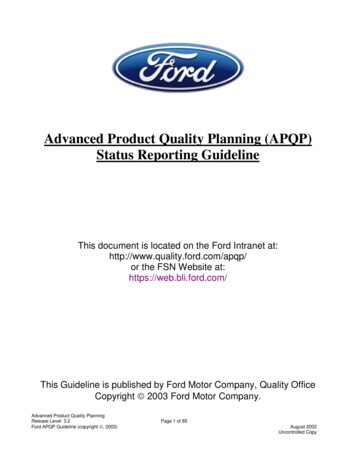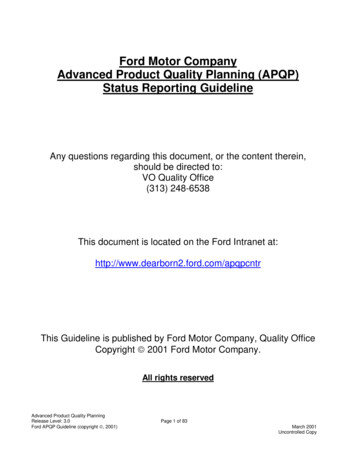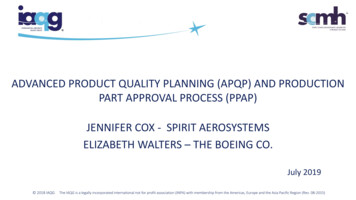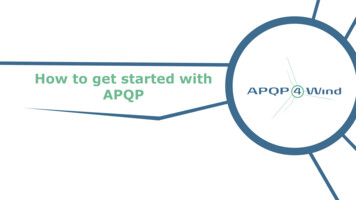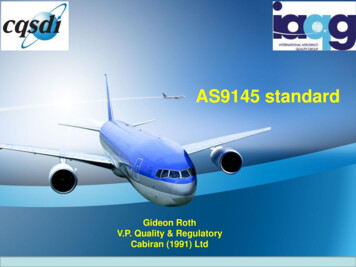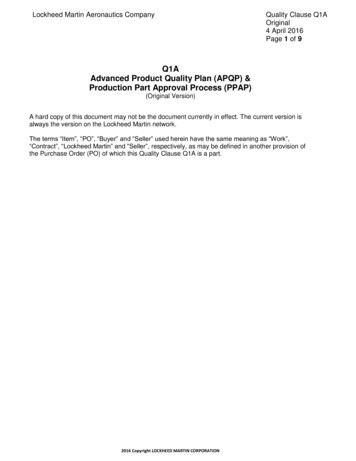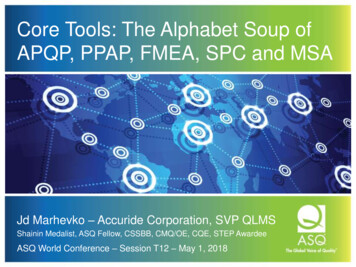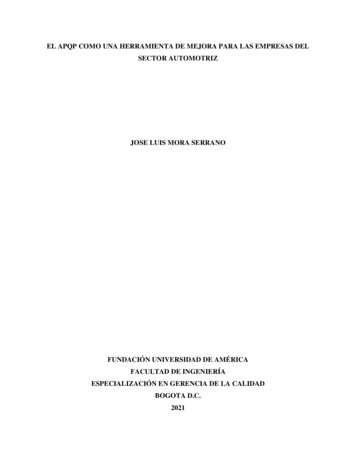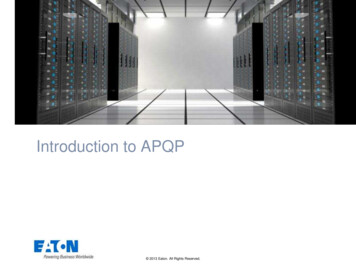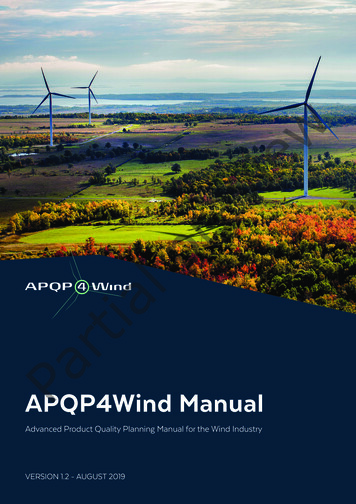
Transcription
Revision no:02Author:Approver:Anna SezonowiczGlobal Supplier QualityAssurance NetworkDate:2019-10-28Title: H-APQP Template ManualPurpose and ScopeThis document is aimed at internal and external stakeholders to describe the use of theH-APQP Template.ContentsIntroduction H-APQP . 20.PCP - Husqvarna Specification Prerequisites. 31.Planning and Definition . 32.Manufacturing Process Design and Development . 63.Engineering Pilot and Design Samples – Pre series run . 94.Significant Production Run – Product and Process Validation . 105.PPAP-documents for submission to Husqvarna . 126.Husqvarna approval, start of serial production and delivery . 121
Revision no:02Author:Approver:Anna SezonowiczGlobal Supplier QualityAssurance NetworkDate:2019-10-28Introduction H-APQPDevelopment of a part for a customer project will require development of the partsmanufacturing process. The manufacturing process must be approved before parts aredelivered for serial production. The approval process is called PPAP (Production PartApproval Process). Among others PPAP serves to: provide evidence that the customer engineering design record and specificationrequirements are clearly understood and fulfilled by the supplierensure that a supplier can meet the manufacturability and quality requirements ofthe part supplied to the customerSeveral activities need to be scheduled and performed already from the start of the partdevelopment. Therefore a part quality plan for developing and validating the productionprocess is necessary to assure achieving part approval (PPAP approval) on time.APQP (Advanced Part Quality Planning) is a method for part quality planning developedby AIAG (Automotive Industry Action Group).The Husqvarna method for part quality planning is called H-APQP (Husqvarna AdvancedPart Quality Planning). It is similar to APQP but in some aspects adapted to fit Husqvarnarequirements.The supplier is responsible of maintaining the APQP activity plan and reporting toHusqvarna as agreed.The protocol used between the supplier and SQA for assuring part quality and tracking ofthe progress is the H-APQP template. The intended use of the H-APQP Template isdescribed below.2
Revision no:02Author:Approver:Anna SezonowiczGlobal Supplier QualityAssurance NetworkDate:2019-10-280. PCP - Husqvarna Specification PrerequisitesOnly for internal review of APQP planning and definitions activities.1. Planning and DefinitionChapter one is about understanding customer requirements and adding extra value in theform of supplier experiences and expertise to meet and exceed customer expectations. Itis also purposed to provide input for chapter two where the initial assessments andreviews will be refined in to near finished forms of process features.I. APQP Kick-off Meeting.Supplier Quality Engineer at Husqvarna is responsible to organize APQP Kick OffMeeting. The purpose of this meeting is to establish a common understanding of APQPrequirements, review of project timeline with important milestones. Frequency and formatof follow up meetings needs to be agreed during APQP Kick Off Meeting.SQA, R&D, Project Sourcing and Responsible Project Team Members from Supplier sideshould be part of APQP Kick Off Meeting.1.1 Voice of customer data”Voice of customer data” has a wide definition but may in the H-APQP be limited to focuson lessons learned from similar parts and projects. It should also provide the supplier of ageneral knowledge about critical functions and features of the part in its application. Itshould make use of any experience and information that may yield valuable input on whatto avoid or what to improve on specifications, production methods, part features etc.Examples of what to review: Historical data of claims and disturbances for similar parts, such as:o Claim statisticso 8D-reportso Known field incidents from product end-userso Incidents that has caused disturbances on the customer production line. The supplier should be informed of how the part functionality has influence on theend user, distributors/retailers, and customer assembly. The information mayinclude:o Safety critical product functions related to the parto How will a part failure influence product performance and the end user?o Will the appearance, form fit and function influence customer appeal in stores?o Features critical for assembly If available, the supplier should present lessons learned from other projectsinvolving similar parts, part features or production processes etc.3
Revision no:02Author:Approver:Anna SezonowiczGlobal Supplier QualityAssurance NetworkDate:2019-10-281.2 EDR (External Drawing Review) with HusqvarnaA design review together with Husqvarna is required for all parts. Husqvarna will invite tothe design review. An official protocol will be signed by the participants.At least H-APQP items:1.2.1 Engineering/Technical Specification review1.2.2 Special/Critical Characteristics reviewed, Capability requirements confirmed1.5 Feasibility study completed with result feasibleMust be completed before the EDR1.2.1 Engineering/Technical Specification ReviewedThe suppliers detailed review of and understanding of specifications will help theorganization to establish what is required to put the design in to production, includingnecessary process control.Are all requirements understood?Are all technical specifications referred to on the drawings available?Are there any requirements that needs special consideration, pressure testing, bursttests, etc.?The supplier should be able to show a protocol including their conclusions from thereview and any drawing criticism or questions that needs to be addressed to Husqvarna.The review should also been seen as preparation for the EDR.1.2.2 Special/Critical Characteristics reviewed, Capability requirementsconfirmedSpecial attention needs to be paid to special/critical characteristics and capabilityrequirements. An initial plan for how these requirements will be controlled is necessaryand must be considered in control plans and work instructions.1.2.3 Preliminary process flow chart and Bill of material establishedThe preliminary process flow chart is used to describe the process and discuss thedifferent steps with Husqvarna as required. Special processes, processes in separateworkflows, processes out of house, etc. must be included.If any component/materials are considered critical for quality or procurement reasons, I.e.master batches, electrical components, it needs to be discussed with Husqvarna.If components are not specified by Husqvarna, the supplier needs to make a preliminaryBOM and include all components that could become necessary.4
Revision no:02Author:Approver:Anna SezonowiczGlobal Supplier QualityAssurance NetworkDate:2019-10-281.2.4 New Tooling, Equipment and Facilities requirements establishedNeed of new tooling equipment or facilities that necessary to fulfill capacity, capability orother specification requirements must be established. A plan for procurement andproduction of equipment needs to be presented.Existing equipment intended to be used should be reviewed to exclude the need ofprocurement. The equipment/tooling should be listed with the individual id number of themachine for each relevant process step.Suppliers with multiple manufacturing sites should inform at which facility parts will beproduced.1.2.5 New Gauges/Fixtures/Testing equipment requirements establishedNeed of new equipment that may be necessary are to be established and a plan forprocurement needs to be presented.All existing equipment intended for use should be reviewed to exclude the need ofprocurement. These should be listed with the individual equipment id number for eachfeature to be controlled. For certain equipment it may be necessary to verify that requiredcapacity is available.Special attention needs to be paid to special/critical characteristics, capabilityrequirements as reviewed in 1.2.2 “Special/Critical Characteristics reviewed, Capabilityrequirements confirmed”.1.3 Initial capacity assessment doneIs there sufficient production capacity for agreed yearly and peak volumes?Information about production manning, scrap rate, set up times and available set upspecialists, supporting functions and measuring capacity should be considered.1.4 Tier 2 suppliers identified and audited with approved resultTier 2 suppliers need to be audited, especially if the tier 2 supplier is a new supplier.Exceptions may be made for raw material and others.The audit should be done with a sufficient audit template and reviewed by Husqvarna.Deviations need to have actions defined and a date for completion and follow up.1.5 Feasibility study completed with result feasibleCustomer design ownership does not remove the responsibility to assess the designfeasibility from the supplier. The supplier need to establish that the suggested design canbe manufactured, assembled, tested, packaged etc. in a way that will meet Husqvarnaquality requirements.A protocol from the feasibility study should be presented.5
Revision no:02Author:Approver:Anna SezonowiczGlobal Supplier QualityAssurance NetworkDate:2019-10-28II. APQP and PPAP EducationIn order to ensure understanding of Husqvarna requirements detail APQP and PPAPtraining needs to be held with the supplier.Training at Supplier site is a recommendation in order to assure effectiveness and havepossibility to answer detail questions concerning APQP component.2. Manufacturing Process Design and DevelopmentChapter two is about the design and development of the process to a near final form tobe verified and approved in the following chapters.2.1 Packaging standards establishedAs a minimum requirement, the packaging suggested by the supplier shall fulfillrequirements in the Husqvarna packaging manual. Rust prevention, scratch prevention,handle ability at point of usage etc., must also considered as applicable. The packagingshould be suitable from a quality perspective, ensure effective transportation and becompatible with material handling systems and storages at the Husqvarna site.2.2 Process Flowcharts createdThe process flowchart shall include all processes and process steps. It will describe theprocess flow including processes not done in-house.The process flowchart is part number specific. All steps must be numbered andreferenced as in the P-FMEA and the control plan.Trading companies or sites that do not have any production in house should have a flowchart for internal flows including in-coming inspection, handling, picking and dispatch etc.2.3 Process Failure Mode and Effect Analysis P-FMEAThe P-FMEA is an analysis to determine, anticipate, resolve or monitor problems in theprocess. It is the primary risk evaluation document in the PPAP-documentation. It willdetermine what risks that need to be reduced or eliminated prior production start andwhat needs to be considered in the control plan to reduce or eliminate remaining risks.The P-FMEA shall include all process steps, the rating needs to be done according tostandard (refer to AIAG), numbering and references must correspond to the ProcessFlow chart and Control Plan. Further it is part number specific and shall include logisticsoperations such as goods reception, storage, shipping etc. The P-FMEA shall includespecial processes and steps not done in house, such as surface treatment etc.6
Revision no:02Author:Approver:Anna SezonowiczGlobal Supplier QualityAssurance NetworkDate:2019-10-282.4 Pre Series Control PlanThere must be a control plan in place for each pre-series production. The pre-seriescontrol plan should consider any extra quality control needed if planned series equipmentsuch as control fixtures, poka yoke, automation etc. is not yet in place or the operatorsare not yet fully trained.2.5 Measurement System Requirement EstablishedA plan to ensure that all measurement systems are validated fit for their purpose andready on time is required. This involves repeatability, accuracy, correlation of duplicategages etc. Special attention needs to be paid to Special Characteristics (SC) and criticaldimensions.The supplier must be able to show that dimensions are measured with adequatemethods. If not - is there a need for further fixtures? Is there a need for measuring somedimensions with CMM? MSA should be done at least for critical dimensions.2.6 New tooling, Equipment and facilities procured and installedCompare to the list of procurement needs - 1.5 New Tooling, Equipment and Facilitiesrequirements established. Will all necessary equipment be installed and approved ontime? Corrective actions need to be presented for any gaps.2.7 New Gauges/Fixtures/Testing Equipment procured and installedCompare to the list of procurement needs - 1.6 New Gauges/Fixtures/Testing equipmentrequirements established. Will all necessary equipment be installed and approved ontime? Corrective actions need to be presented for any gaps.2.8 Equipment set-up procedures established and documentedSet-up procedures must be mapped and instructions created. This include specialprocedures such as set up of test equipment, calibration of weight scales etc.2.9 Work instructions developedOperators work instructions need to be created, also for supporting processes such asmaterial handling and packaging, quality control etc. Instructions should be developedfrom the sources of FMEA, control plan, part specifications, process parameters,organization expertise, customer expectations etc.7
Revision no:02Author:Approver:Anna SezonowiczGlobal Supplier QualityAssurance NetworkDate:2019-10-282.10 Training of personnel planned and initiatedExisting competence must be mapped and compared with competence needed toperform all operations in the flow, also including supporting functions such as materialhandling and logistics, shipping and dispatch, customer support (deviations management)etc.Any process of which the supplier has no previous experience is of extra relevance. I.e.an assembly operation performed by an organization primarily set up to run tooling basedbatch-production.It is recommended to use a competence matrix to conclude current competence level andfind any gaps.A training plan needs to be presented before closing 2.10.2.11 Quality assurance of parts from Tier 2 suppliers doneParts and material procured from Tier 2 suppliers need to be quality assured. Thesupplier is responsible for sub-supplier quality. This is also applicable when sub-suppliersare assigned by Husqvarna, unless written agreements state differently.Tier 2 part quality should be assured by sub-supplier APQP and sub-supplier PPAP.There must be a plan with scheduled activities to assure part quality. Examples of itemsto follow up are drawing review, feasibility study, control plan, work instructions, finalinspection in series production, etc.2.12 Preliminary Husqvarna delivery plan receivedHusqvarna should send forecasted delivery schedules as soon as feasible. The suppliershould confirm the delivery schedules and that their material planning supplier system isset up correctly so that production and dispatches will be made accordingly and deliveryschedules are generated and transmitted to tier 2 suppliers.2.13 Preliminary Tier 2 delivery plan communicatedThe supplier shall make sure that tier 2 suppliers receives delivery schedules asgenerated from the supplier and that tier 2 material planning is adequate.8
Revision no:02Author:Approver:Anna SezonowiczGlobal Supplier QualityAssurance NetworkDate:2019-10-283. Engineering Pilot and Design Samples – Pre series runEngineering Pilots (EP) are prototype builds to verify and improve the part design. Theremay be several EPs during the project. Design Samples (DS) are to verify the readinessto call off PPAP and it is of importance for both customer and supplier to carefully followup on any deviations found.3.1 Engineering Pilot - Pre series runEngineering Pilot should be included in the project time plan communicated to thesupplier who shall confirm and plan accordingly.3.2 Measurement System Analysis (MSA)If relevant, the measuring devices and systems should be evaluated and verified priorEngineering Pilot and Design Samples.3.3 Design Samples – Dimensional, material and testing verificationDesign Samples need to be delivered together with dimensional report on time. Refer toH-QAP for the definition of design samples. The supplier shall confirm that the designsamples are manufactured using series tooling, with correct production data, material anddimensions. However, the complete, final and documented production process is notrequired. The samples should in first hand be produced at the supplier location. If not, byapproved corresponding conditions. This must be clearly communicated to Husqvarna.Husqvarna will provide feedback to the dimensional report and in case of deviations thesupplier will receive a request for corrective actions, or information on any actions fromHusqvarna. It is the suppliers responsibility to make sure that deviations are correctedbefore submitting PPAP-samples.III. Husqvarna Feedback on EP samplesHusqvarna R&D need to provide feedback on EP samples to the supplier. The feedbackshould be based on dimensional and verification result, material certificate etc. providedby supplier and contain information regarding needed improvement.9
Revision no:02Author:Approver:Anna SezonowiczGlobal Supplier QualityAssurance NetworkDate:2019-10-284. Significant Production Run – Product and ProcessValidationThe design of manufacturing process should now be ready for validation by productionrun, capability studies etc.VI. SQA visit on site during Significant Production RunSQA Engineer together with supplier should if possible plan a visit on supplier site duringPPAP production. Initial PPAP documentation should be provided prior to SignificantProduction Run.4.1 Significant Production Run using Full Run Test TemplateThe output of the significant production run is used for evaluation and review of theproduction process. The minimum quantity to be produced is decided by/with Husqvarna.The Husqvarna Full Run Test template shall be used as far as applicable fordocumenting and evaluating the production run. Samples from the significant productionrun shall be included in PPAP (PPAP-samples).4.2 Measurement System Analysis (MSA)Monitoring and measuring devices need to be evaluated during or prior to the SignificantProduction Run. MSA shall be submitted in PPAP as requested.4.3 Initial SamplesAlso known as PPAP-samples. Shall be produced with series tooling using the productionprocess checked with all intended control devices such as described in the control plan.Operators shall be ready and trained working as described in work instructions for seriesproduction.4.4 Process Capability StudyCapability needs to be shown according to the Husqvarna Quality Assurance Process (HQAP). A Process Capability Study should be available for all characteristics identified inthe control plan. It is required for significant characteristics as a minimum.4.5 Scrap rate calculated and action plan established if necessaryScrap rates should be calculated during the Significant Production Run using the Full RunTest Template, or others if adequate. The scrap rate calculation will indicate if theprocess is working as intended and if appropriate actions are taken when defects arediscovered during production.10
Revision no:02Author:Approver:Anna SezonowiczGlobal Supplier QualityAssurance NetworkDate:2019-10-284.6 Capacity verified (Cycle/Tact times verified)The capacity should be verified during the Significant Production Run as defined in theFull Run Test Template or, or others if adequate. The verification will indicate if thecalculated capacity is available or if actions are required.4.7 Production Control Plan establishedVerify that the control plan is complete, updated according to latest drawings andcorresponds to FMEA and work instructions.4.8 Training of personnel completedVerify that all operators are trained as required and defined in 2.10, including supportingfunctions. There should be a competence matrix or equivalent to show current status oftraining.4.9 Packaging requirements verified to ensure part integrity at point of useVerify that the packaging and unit loads are accepted by all receiving Husqvarna sites.The packaging should be suitable from a quality perspective, ensure effectivetransportation and be compatible with material handling systems and storages at eachHusqvarna site. See also 2.1.4.10 Master sample stored at supplierWhen master samples are considered required Husqvarna and the supplier shall agreeupon how these are to be handled, unless that is not already covered in contractualagreements or other relevant documents or specifications.A possible way of managing master samples is to have an agreed number of signedmaster samples stored by Husqvarna and equal signed samples stored by the supplier. Italso need to be agreed in detail what is governed by the master samples and what is not.Brightness, porosity, scratches are some examples.Color samples can be ordered from Husqvarna. It is the responsibility of the supplier toorder these, to store them properly and to re-order color samples as necessary due toaging.11
Revision no:02Author:Approver:Anna SezonowiczGlobal Supplier QualityAssurance NetworkDate:2019-10-285. PPAP-documents for submission to HusqvarnaChapter 5 is a listing of PPAP documentation for the purpose of establishing what isrequired and what is the current state of the PPAP-documentation. PPAP must be ok andbe ready for approval at first submission.For reference look at Husqvarna Quality Assurance Process (H-QAP) and AIAG PPAPmanual.V. Husqvarna Feedback on PPAPHusqvarna needs to provide feedback on PPAP by sending back signed PSW withcorresponding nonconformities and remark report if applicable.6. Husqvarna approval, start of serial production and deliveryClosure of the project by summarizing lessons learned, start of continuous improvementsin serial production.6.1 Statistical Process Control for reducing variation initiatedStatistical Process Control (SPC) will provide data usable for continuous improvements toreduce variation in a process. The collection and analysis of data shall be reviewed whenapplicable.6.2 Husqvarna delivery plan received and confirmedHusqvarna delivery schedules should be compared with the supplier MPS output toconfirm that the schedules are received and processed correctly.6.3 Tier 2 supplier delivery plan communicated and confirmedConfirm that schedules are transmitted to the Tier 2 suppliers and that the Tier 2suppliers are able to receive and plan production and shipping accordingly.6.4 Effective use of lesson learnt and best practicesBefore closing any project the lessons learnt need to be documented by the project teamtogether with project stakeholders if applicable. There should be a template or method forconducting lessons learnt. As a minimum there shall be a list of “Things Gone Good” and“Things Gone Bad”. All listed items need to have actions to carry over good experiencesto new projects and to avoid repeating deviations in the future.12
I. APQP Kick-off Meeting. Supplier Quality Engineer at Husqvarna is responsible to organize APQP Kick Off Meeting. The purpose of this meeting is to establish a common understanding of APQP requirements, review of project timeline with important milestones. Frequency and format of follow up meetings needs to be agreed during APQP Kick Off Meeting.
